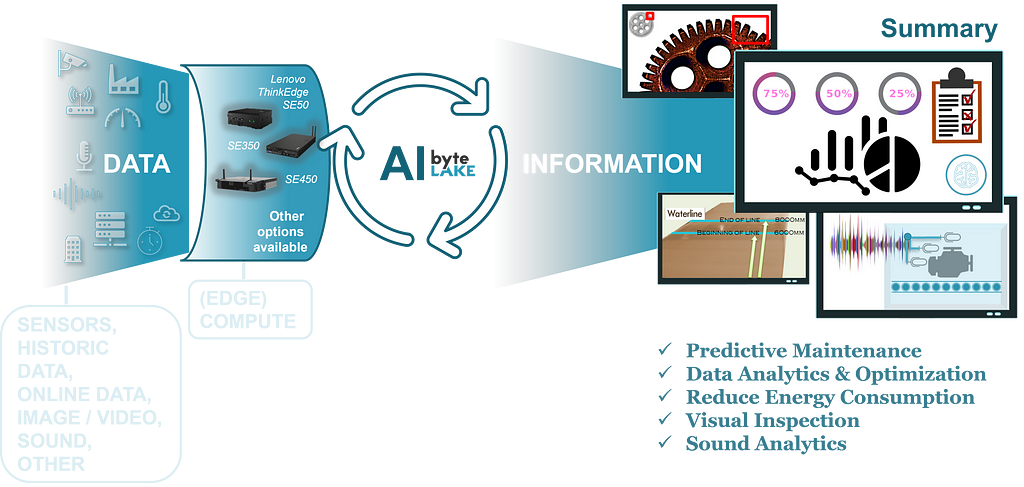Evolution of Supply Chain Management Through Big Data Implementation
REGRIP, Pioneer in Reengineered Tyres, Raises $2M Funding from SiriusOne Capital
How Beliefs & Ideology Shape your World
Beliefs & Ideology are our Operating System
Continue reading on Becoming Human: Artificial Intelligence Magazine »
AI is… about FINDING ANSWERS in the DATA.
We all collect data. So do all industries. But what’s the first step in planning the AI transformation? Finding a scenario where AI could help.
I’ve been writing about AI for quite some time now. Through numerous webinars and discussions, I’ve come to a conclusion: perhaps I’ve been focusing too much on the implementation and deployment of AI. During these conversations, it became evident that many industry leaders face a common challenge — they struggle to identify a starting point for integrating AI into their operations.
The more I engage with industry professionals, the more I understand the critical importance of addressing the fundamental question: Where does one begin the journey towards AI integration?
Before AI can even grace the agenda of workshops or meetings, organizations grapple with the daunting task of pinpointing how and where AI can be leveraged to drive meaningful impact. It’s not merely about deploying AI; it’s about finding the right scenario, the pivotal moment where AI can unravel insights and catalyze transformation.
This blog post will focus on just that: a list of a few pathways you can consider while jogging, swimming, surfing, or engaging in any activity before you jump into your car and head to meet your teams.
So what’s AI? While there are many definitions, we at byteLAKE say that AI is about transforming DATA into ACTIONABLE INSIGHTS.

And now, where could be your starting point for AI
If you happen to work in manufacturing, consider these scenarios:
- Automated visual inspection of products, parts, and components: cameras can help you automate quality inspections, detecting scratches, dents, paint chips, etc. AI can analyze images of your products and validate colors, prints, labels, etc.
- IoT sensors data analytics typically leads to implementing scenarios like predictive maintenance for better insights into processes, lowering the amount of unplanned downtimes, detecting risks earlier, etc.
- General data analytics typically helps find optimal setups or configurations to reduce energy consumption, identify reasons for incidents, etc.
In logistics, AI is typically used to automate counting, ensuring the quality of shipments, etc. A common phrase I have been hearing in that sector is along the lines of: if we ship too many products, hardly ever someone informs us about that. But, if we forget to send anything, we always get complaints which impact our reputation. Therefore, if working in logistics, think of scenarios where:
- Cameras can help you count products, analyze what you put into containers and, for instance, trigger an alarm if the wrong barcode or an expired product is detected.
- AI can count boxes, automate inventory processes, and, very much like in manufacturing, monitor overall quality: checking labels, validating documents, inspecting packaging, etc.
I need to explicitly mention the paper industry as we have been delivering AI solutions there for many years now. I assume that not many of my readers know, but AI can visually inspect the whole process and, for instance, detect quality issues in the paper sheets, boxes (i.e., missing prints, wrong labels), or monitor the papermaking process by measuring and analyzing the so-called wet line, aka waterline.
The automotive industry, another exciting sector with huge potential for AI, has seen significant progress. Most of the already mentioned aspects would apply there as well. Besides visual inspections and data analytics, sound analytics is embraced on assembly lines. AI can, for instance, analyze the sound produced by car engines or various car components like pumps, bearings, etc., and detect nuances that can identify faults or errors.
Let me finish this blog post by mentioning the energy sector where AI can, for instance, help you analyze all the data generated by various sensors attached across your infrastructure and suggest, for instance, optimal settings to minimize downtimes, reduce overall energy consumption, or improve reliability and client satisfaction.
can help you find answers within the vast expanse of data, enabling data-driven decisions. It can take into account readings from IoT sensors as well as your teams by analyzing their inputs, combining all of these with online data like weather forecasts, regulations, etc., and taking actions to minimize risks, identify issues, and suggest optimizations.
And I could continue listing other examples as basically EVERY industry has areas where AI can easily automate or optimize various operations. And of course, AI is not just a camera or intelligent sensor. It typically builds up into a robotic arm or a software system that either moves things around and AI becomes just a set of workers focused on certain things like:
- AI-robot #1 performs visual inspection
- AI-robot #2 performs data analytics
- …
- AI-robot #n consolidates all of these and turns everything into information: SET parameters X, Y, Z to A, B, C, respectively to reduce energy consumption by 30%, avoid downtimes and send maintenance teams to area #41 and #51.
Although there are other areas where AI can help like, for instance, the back office of all mentioned industries (document processing, boring office task automation, etc.), I hope this blog post will still help at least some of you identify the first one or yet another area where to start your next AI journey. Have a great weekend!
https://medium.com/media/20f6637885c3f261f9c27f3a9f60951b/href
AI is… about FINDING ANSWERS in the DATA. was originally published in Becoming Human: Artificial Intelligence Magazine on Medium, where people are continuing the conversation by highlighting and responding to this story.
Nowruz Wisdom: Learning from the Haft-Seen for a Tech-Forward Future

Happy Nowruz. As we usher in the spring season, let’s embrace the wisdom of the traditional Haft-Seen table.
Celebrated by around 300 million people globally, including many across the United States, Nowruz marks the first day of Spring and the New Year. The Haft-Seen, with its seven symbolic items each beginning with the letter ‘S’ in Persian, offers lessons for our journey through the new digital age:
- Sabzeh (Sprouts) — Just as sprouts signify new beginnings, AI represents a new era of growth and innovation. We’re reminded to embrace change and the fresh perspectives it brings.
- Sumac (Spice of Life) — Sumac, with its vibrant color and flavor, symbolizes the diversity and richness of life. It’s a call to ensure that AI adds value and diversity to our existence, not just efficiency.
- Samanu (Sweet Pudding) — The intricate process of making Samanu reflects the complexity behind AI technologies. It teaches us that patience and careful cultivation can lead to rewarding outcomes.
- Senjed (Dried Oleaster Fruit) — Senjed symbolizes love, reminding us to maintain humanity and empathy in a world increasingly run by algorithms. Ensuring AI enhances human connections is crucial.
- Seer (Garlic) — Garlic, known for its medicinal properties, can be likened to the role of AI in healthcare—offering the potential for healing and fostering well-being.
- Seeb (Apple) — The apple represents beauty, reminding us that in our pursuit of technological advancement, we should also appreciate and cultivate the aesthetic and creative aspects of life.
- Serkeh (Vinegar) — Vinegar symbolizes age and patience. It teaches us that while technology moves fast, patience and persistence are vital in ensuring sustainable and thoughtful progress.

In addition to the seven “S” items of the Haft-Seen, the Nowruz table often includes a mirror, a book of poetry, candles, a goldfish in a bowl, hyacinth, sweets, and coins, each gaining new significance as I get older. The mirror encourages introspection in a digital world, reflecting our values against the backdrop of technology.
Poetry preserves the essence of emotion and art. Candles symbolize the human spirit’s resilience against technological domination. The goldfish, in its fluid grace, reminds us of life’s vitality within structured environments. Hyacinths represent the integration of nature with technology, emphasizing growth and renewal.
Sweets remind us to savor life’s joys and connections beyond digital interactions. Lastly, coins point to new economic dynamics that await us.
As my family and I celebrate the Nowruz season, these reflections from the Haft-Seen table inspire me to meet the future with a blend of tradition and innovation. Wishing everyone a Nowruz filled with growth, health, and joyful discovery.
This content was crafted with the assistance of artificial intelligence, which contributed to structuring the narrative, ensuring grammatical accuracy, and summarizing key points to enhance the readability and coherence of the material.
Nowruz Wisdom: Learning from the Haft-Seen for a Tech-Forward Future was originally published in Becoming Human: Artificial Intelligence Magazine on Medium, where people are continuing the conversation by highlighting and responding to this story.
